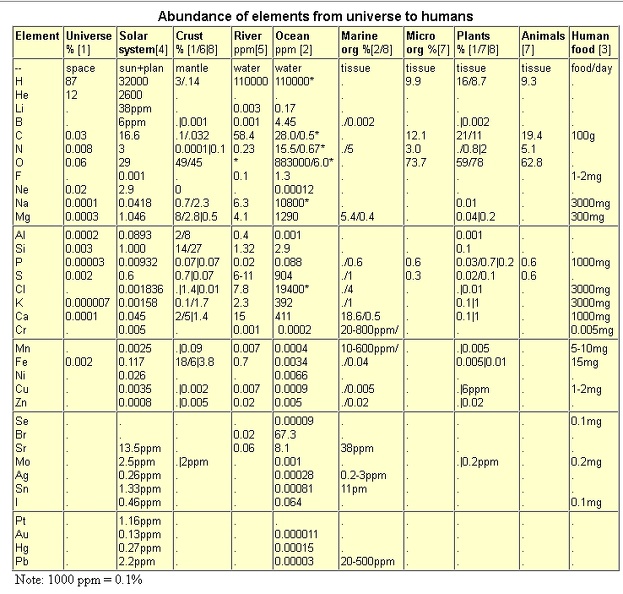Post by 1dave on Aug 23, 2019 15:25:10 GMT -5
Stardust
articles.adsabs.harvard.edu//full/1990pihl.book..207L/0000208.000.html

I. Chondritic particles are the majority (60%). The texture of the dust particles do not show the fibrous structures common in classes Cl and C2 carbonaceous chondrite meteorites. This has been taken as argument that they formed in a different environment to that of the chondritic meteorites. They consist of the lightest elements:
Hydrogen 87%, Helium 12%, Carbon 0.03, Nitrogen 0.008, Oxygen 0.06, Neon 0.02, Sodium (Na) 0.0001, Magnesium 0.0003, Aluminum 0.0002, Silicon 0.003, Fluorine 0.00003, Sulfur 0.002, Potassium (K) 0.000007, Calcium 0.0001, Iron (Fe) 0.002.
2. A large fraction (30%) of the collected particles were of composition iron-sulfur-nickel. where the nickel is a few percent addition to an iron-sulfide mineral. These particles are among the smallest collected. Some have the form of spheres, which may be the result of melting during entry into the atmosphere (Fig, 5.10), but also platelets or single crystals occur.
Iron 48%, Sulfur 48%, Nickel 2-4%.
3. About 10% of the collected particles were classified as mafic silicates consisting mainly of the minerals olivine or pyroxene.
Olivine minerals that have compositions that typically range between Mg2SiO4 and Fe2SiO4.
Pyroxenes have the general formula XY(Si,Al)2O6, where X represents calcium, sodium, iron (II) or magnesium and more rarely zinc, manganese or lithium, and Y represents ions of smaller size, such as chromium, aluminum, iron (III), magnesium, cobalt, manganese, scandium, titanium, vanadium or even iron (II).[/b]
Pyroxenes that crystallize in the monoclinic system are known as clinopyroxenes and those that crystalize in the orthorhombic system are known as orthopyroxenes.
My best guess is that group 1 is from the very first supernovas after the big bang, 2 from 2nd generation, and 3 from third generation supernovas as stars became more and more massive.

The earth is 4.54 billion years old. It travels in the solar system around the Milky Way galaxy once every 226 million years - ONE Galactic Year - so earth has made the trip about 20 times.
Earth is now in the same galactic position of 226 million years ago, during the Triassic and 452 million years ago during the Ordovician and 678 Ma during the Precambrian. How different are the IDP’s now from then? How have the IDP’s changed over time?
Is there a consistent repetitive change in soils, a pattern that can be identified as the earth repeated its journey around the galaxy?



At present earth grows by about 10,000 tons of Interplanetary Dust Particles (IDP’s) every Solar year.
That adds up to 10,000,000,000 tons every million years!
There appears to be 3 different groups of IDP’s arriving now.
articles.adsabs.harvard.edu//full/1990pihl.book..207L/0000208.000.html

I. Chondritic particles are the majority (60%). The texture of the dust particles do not show the fibrous structures common in classes Cl and C2 carbonaceous chondrite meteorites. This has been taken as argument that they formed in a different environment to that of the chondritic meteorites. They consist of the lightest elements:
Hydrogen 87%, Helium 12%, Carbon 0.03, Nitrogen 0.008, Oxygen 0.06, Neon 0.02, Sodium (Na) 0.0001, Magnesium 0.0003, Aluminum 0.0002, Silicon 0.003, Fluorine 0.00003, Sulfur 0.002, Potassium (K) 0.000007, Calcium 0.0001, Iron (Fe) 0.002.
2. A large fraction (30%) of the collected particles were of composition iron-sulfur-nickel. where the nickel is a few percent addition to an iron-sulfide mineral. These particles are among the smallest collected. Some have the form of spheres, which may be the result of melting during entry into the atmosphere (Fig, 5.10), but also platelets or single crystals occur.
Iron 48%, Sulfur 48%, Nickel 2-4%.
3. About 10% of the collected particles were classified as mafic silicates consisting mainly of the minerals olivine or pyroxene.
Olivine minerals that have compositions that typically range between Mg2SiO4 and Fe2SiO4.
Pyroxenes have the general formula XY(Si,Al)2O6, where X represents calcium, sodium, iron (II) or magnesium and more rarely zinc, manganese or lithium, and Y represents ions of smaller size, such as chromium, aluminum, iron (III), magnesium, cobalt, manganese, scandium, titanium, vanadium or even iron (II).[/b]
Pyroxenes that crystallize in the monoclinic system are known as clinopyroxenes and those that crystalize in the orthorhombic system are known as orthopyroxenes.
My best guess is that group 1 is from the very first supernovas after the big bang, 2 from 2nd generation, and 3 from third generation supernovas as stars became more and more massive.
Where and When did the copper, silver, and gold come from?

The earth is 4.54 billion years old. It travels in the solar system around the Milky Way galaxy once every 226 million years - ONE Galactic Year - so earth has made the trip about 20 times.
Earth is now in the same galactic position of 226 million years ago, during the Triassic and 452 million years ago during the Ordovician and 678 Ma during the Precambrian. How different are the IDP’s now from then? How have the IDP’s changed over time?
Is there a consistent repetitive change in soils, a pattern that can be identified as the earth repeated its journey around the galaxy?















